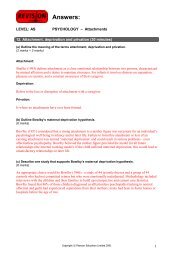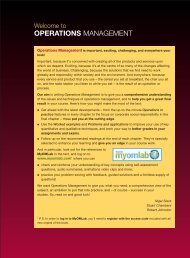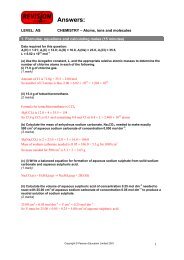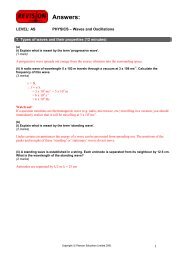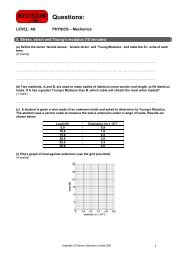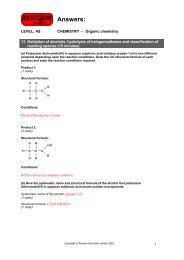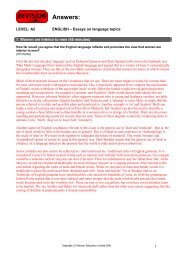appendix: Tetrylus Inc business plan - Pearson
appendix: Tetrylus Inc business plan - Pearson
appendix: Tetrylus Inc business plan - Pearson
Create successful ePaper yourself
Turn your PDF publications into a flip-book with our unique Google optimized e-Paper software.
12. Risk analysis<br />
See Chapter 11, pp. 223–49<br />
RISK assessment<br />
SWOT<br />
We have analyzed our strengths and weaknesses, and the opportunities for<br />
and threats to the <strong>business</strong>. The key items are listed below, each with a note<br />
explaining how we will cope with, or exploit, the issue …<br />
Critical success factors<br />
We have determined that we must achieve the following targets in order to<br />
move our strategy forward. Most critical is the need to source … We are<br />
implementing a four-step program to ensure that we meet the requirements<br />
… The first step is to …<br />
Limiting factors<br />
There are two things which could limit our sales in year one and … First,<br />
there is a constraint on the amount of … that we can source until we have …<br />
Of course, these limits are way beyond the sales volumes that we can<br />
reasonably hope to achieve. Moreover, …<br />
Specific risks and their solutions<br />
There are eight specific risks to which we should draw attention … We have<br />
strategies to deal with each of these risks, as described below.<br />
Production. <strong>Tetrylus</strong> ONE has been successfully prototyped and the<br />
feasibility and cost of the manufacturing process is known. The<br />
manufacturing is undertaken by a company with quality procedures that<br />
meet ISO 9002 standards, and we will conduct our own quality control<br />
sampling at their premises … The one remaining uncontrollable factor<br />
affecting production is the availability and price of silicon on the world<br />
market which …<br />
Alternative scenarios<br />
Our sales forecasts, and projected revenues, costs, and financial statements<br />
are based on the lower-end of our most-likely scenario.<br />
As already discussed, there is a range of possible outcomes dependent on a<br />
wide range of factors both within and outside of our control. Accordingly,<br />
this <strong>plan</strong> includes two alternative scenarios showing how the <strong>business</strong> will<br />
develop under varying conditions. The low-income scenario assumes that<br />
certain unlikely events depress production, sales and prices by … Our<br />
calculations show that we still break even at … and … . We also include a<br />
high-income scenario to show how net profit will rise sharply if …<br />
Sensitivity analysis<br />
The following table shows our assessment of the effects of a 1% increase in<br />
key variables. A 1% decline will have approximately the opposite effect.<br />
You may use this table to assess your own scenarios.<br />
A 1% increase in Net profit<br />
Will change these by<br />
Borrowing ROE<br />
$,000 $,000 %<br />
Sales volume +167 –83 +3.3<br />
Sales price +134 –57 +2.7<br />
Marketing expenditure +15 –8 +0.3<br />
Raw material prices –59 +30 –1.2<br />
Labour costs –23 +12 –0.5<br />
Other costs –12 +5 –0.2<br />
Taken from The Definitive Businss Plan by Richard Stutely, published by <strong>Pearson</strong> Education.<br />
Copyright Richard Stutely 2002. All rights reserved. Not to be reproduced without the prior written consent of the<br />
publishers.<br />
www.<strong>business</strong>-minds.com<br />
Appendix<br />
315




